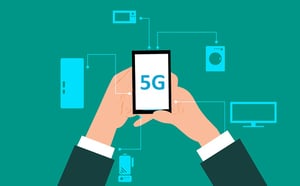
From the earliest primitive means of communication through distinct yet complex sounds to present day advances in telephony and the Internet, the various means of interaction are constantly being upgraded because we are becoming even more impatient, and everything around us just needs to move at our pace.
When it comes to wireless technology, what readily comes to mind are such terminologies as 2G, 3G, and 4G LTE; the latter being the standard mechanism responsible for much of our communication needs. While one may be forgiven for attributing these terms for the speed at which we stay connected to the Internet and one another, the G after the number indicates Generation. Rates are also crucial in this regard and the 4G LTE (Long-term evolution) would naturally quickly convey packets of information across the digital space.
5G Networks amidst Current Realities

You are correct to say that great strides have been made in the evolution of cellular communication. Consider this report that estimates that by 2021 (three years from now) the world will host over 28 billion connected telephones and other smart devices. From this number, a staggering 16 billion will be IoT enabled devices. Despite the earlier stated advancements in cellular technologies, more work needs to be done to cope with billions of people and devices seeking connections over the Internet of things.
Welcome the 5G Revolution, touted as having the ability to disrupt the fundamental ways in which we connect and communicate.
So what exactly is the 5G Network?
At its most basic, 5G is the fifth generation of cellular network technology that enables cell networks to distribute data.
How does a 5G Network work?
5G Networks will use airwaves to transmit data over the air. Developers of this recent technology will use a higher band of frequency, which will translate into higher speeds of connectivity. The basic principle behind the 5G involves the streaming/aggregation of data in parallel and across multiple antennas for each carrier band.
5G Network, Autonomous Vehicles, and Smart Housing

At the moment, industry pacesetters are looking at integrating activities of everyday life with the offerings of a 5G network and so much more. There are hints that there will even be a 5G Galaxy next year. Cars are becoming big mobile computers, equipped with devices and sensors that give drivers a whole range of functionalities. There is work going on in the development of self-driving cars (also referred to as Autonomous Vehicles). These vehicles are able to determine the distance between objects, generating a precise 3D map of the car's surroundings.
There is the other issue of smart housing and cities. These structures feature such functionalities as homeowner voice control modules, remote lighting systems, integrated security protocols (often possessing distress notifications that alert law enforcement agencies), and smart energy saving configurations, among other cutting-edge technologies.
All these cutting-edge technologies will need and generate vast amounts of data for peak performance. Consider, for example, that an autonomous vehicle needs to consume over four terabytes of data for roughly every 8 hours of driving. These packets of information will need immediate conveyance, action, and reaction, especially since, in the case of cars, it can mean the difference between life and death.
To accommodate this considerable data demand from these evolving systems, developers turn to cloud computing to store, process, and transmit these packets of information. This need is solved by integrating 5G networks with smart cars and homes, since it seems the overriding concern is the speed and ability to move copious amounts of data.
The above scenario is true to certain extents. However, some constraints demand careful consideration. The first is the issue of latency. Analysts state that moving such large caches of information across wide area networks stand the high risk of experiencing downtimes and delays in data communication, which could prove fatal.
Process builders are increasingly looking to edge computing in preference to the cloud, to mitigate the effects of network latency. Edge computing aims to act quickly on generated data with minimal delays or downtime. In this regard, manufacturers of autonomous vehicles are opting for configurations and technologies that require minimal connection with the Internet to function.

This particular set-up involves preloading maps and algorithms into the vehicle's navigation system, although the driverless unit still maintains communication with the Internet by providing real-time statistics and other levels of stratified information. In effect, deploying the 5G Network borders on the big issue of reliability, especially when using cloud computing.
Edge computing also comes with other telling challenges, which includes managing the edge nodes that process all the unstructured data/information, as well as instituting privacy requirements for the collection of sensitive data (such as the bio-information of the owner of a smart home).
Is 5G Network configuration the missing link in autonomous vehicles and smart cities? A holistic answer will point to the inherent opportunities/benefits that will accrue and at the same time acknowledging the challenges that exist if the 5G network was deployed now. The common ground of understanding for driving autonomous vehicles and living in smart cities with the 5G networks will look at ways to better efficiently and effectively manage the extraction, processing, analysis, and updating of data. This path sums up to the provision of intelligent data orchestration and management, as well as other structures for a seamless operation.
This post was contributed by Nichole Heydenburg of Apex Waves. Apex Waves provides customers with New, New Surplus, and Refurbished/Reconditioned test equipment including analyzers, counters, Demultiplexers, and more! Consider checking out their website and blog for more information!






